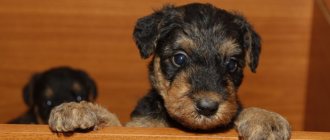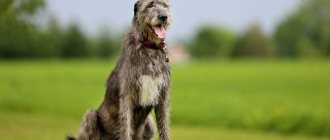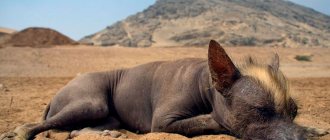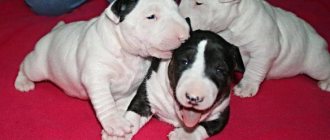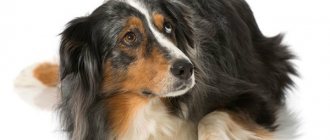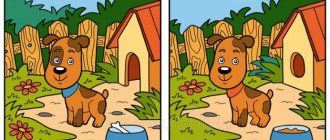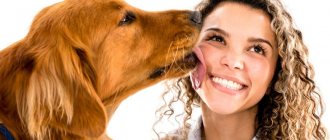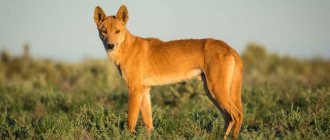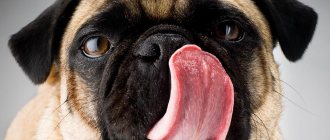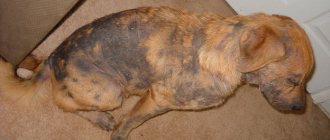- Pets
- >>
- Dog breeds
* Here is a photo of a typical representative of the Czechoslovakian Wolfdog breed . You can send us photos of your animals by email, and we will post them on the website. Don't forget to send your pet's name.
Other breed names:
Czechoslovakian Wolfdog
Brief description of the breed
What is the actual country of origin?
Czechoslovakia
What is the country of origin according to the FCI?
Czechoslovakia
When did the breed appear?
1999
How long does he live?
from 12 to 14 years
How much does a male dog weigh?
from 25 to 29 kg
How much does the bitch weigh?
from 19 to 26 kg
What is the height (height at withers) of a male dog?
from 62 to 67 cm
What is the height (height at withers) of the bitch?
from 58 to 64 cm
How much does a puppy with documents cost?
from 15 to 60 thousand rubles
What is the price of a puppy without documents?
from 5 to 15 thousand rubles
The Czechoslovakian Wolfdog is a unique breed of dog that appeared relatively recently.
This is a successful experiment, which showed that it is possible to cross a dog and a wolf, thereby obtaining excellent dogs with guard qualities. Czechoslovakian Wolfdogs are hardy, active and friendly towards close people, which makes them irreplaceable guards and reliable companions.
Cost and where to buy
This breed is not very common. Few breeders will dare to raise these strong-willed and strong dogs. Therefore, a Czechoslovakian wolfdog puppy is not cheap. On average, the price of a baby is 40-60 thousand rubles (data as of March 2021).
Nurseries
Contact only trusted nurseries. It is strictly forbidden to purchase Volchak by hand. Sometimes unscrupulous breeders can sell a puppy with the makings of aggression. It’s scary to even think about what this baby could grow out of.
Pay attention to the following kennels of the Czechoslovakian Wolfdog breed:
- BEST-DOG-CLUB IKU in Moscow - https://www.alvas.ru/bdc-iku-czech-wolfdog.htm;
- “Luxurious luck” in Yekaterinburg - https://ok.ru/chekhoslov/topic/65328212514050;
- "Alfresco Life" in Chelyabinsk - https://sobaki.pro/index.php?m=Poroda&page=Poroda/Pitomniki&id=Wolf&pit=32758.
If a Czechoslovakian Wolfdog appears in your home, then remember the most important rule - always be on the alert. It is strictly forbidden to treat this pet with connivance. You must not let your guard down—be prepared to calmly and confidently take over the “lamb” in wolf’s clothing in any situation.
Video
* We invite you to watch a video about the Czechoslovakian Wolfdog . In fact, in front of you is a playlist in which you can select and watch any of 20 videos about a given dog breed by simply clicking on the button in the upper right corner of the window. In addition, the material contains quite a lot of photos. By looking at them you can find out what a Czechoslovakian Wolfdog looks like.
In this article:
|
Rate the material!
[Total votes: 1 Average: 5]
How to choose a puppy
Relatively young breeds usually do not have genetic abnormalities or defects, this includes the Czechoslovakian Wolfdog.
The price of a puppy does not correlate in any way with its purebred, so there is no point in focusing on inflated amounts.
Important! One of the main aspects when choosing is the health of the baby’s parents. It would be good if the breeder can also provide their grading. This is a code of Latin numbers and letters, when deciphered you will learn about the dog’s proportions, its shortcomings and temperament, and its compliance with the standard.
After checking the documents, you can begin to examine the doggies. Their health is assessed using the same indicators that apply to the selection of other puppies:
- cleanliness of eyes, nose, ears;
- good condition of coat and skin;
- softness and cleanliness of the tummy;
- presence of a pleasant smell;
- liveliness of temperament, curiosity.
The dog doesn’t care at all what size the one who offends his owners or their children is - the ill-wisher will experience all the ferocity of the wolf
Nicknames and names
New owners rarely retain the official nicknames given to the puppies in the kennel for their pets. As a rule, almost all puppies are renamed, giving them pet names that do not appear in the stud books. They choose names that are sonorous and meaningful for the new owner.
Popular pet names used for the Czech Wolf:
- for males - Bib, Olf, Biker, Jacques, Karol, Erema;
- for bitches - Posya, Ollie, Maggie, Asya, Rusya, Connie, Bizzy.
How much does a wolfdog puppy cost?
The price of a Czechoslovakian Wolfdog puppy with a good pedigree from parents with awards and achievements will vary from 40,000 to 50,000 rubles.
The Czechoslovakian Wolfdog is a mixture of dog and wolf. It is worth purchasing it only for a specific purpose and for a reason.
History of the origin of Czechoslovakian wolfdogs
The Czechoslovakian Wolfdog, also known as the Czech Wolfdog, has an open history of origin. This sets it apart from many other breeds that have dark spots in their history. The Czechoslovakian Wolfdog emerged through deliberate experimentation in the mid-twentieth century.
The socialist government of the Czech Republic in 1955 had one of the military canine goals: obtaining a hybrid of a wolf and a dog. Similar experiments have already been carried out in different countries of the world, but were not successful - the wolf element always won in the dog, and they ran wild.
Czech breeders were confident that wolves and dogs do not have a common ancestor, so they can produce good offspring after crossing, and these offspring are fertile. This point is especially important since many attempts to cross a wolf and a dog have produced completely sterile offspring.
The breeding of the Czechoslovakian Wolfdog was carried out under the supervision of Karel Hartl, a representative of the Czechoslovakian army. Four wolves were caught and named Lady, Sharik, Brita and Argo. They also selected 48 purebred German shepherds, the best representatives of their breed. The first offspring of wolves and shepherd dogs turned out to be fertile.
For ten years, this crossing produced fertile offspring. The resulting individuals had an interesting exterior and a unique character, not similar to either a dog or a wolf. These dogs rarely barked and behaved extremely reservedly.
Interesting fact: The experiment was completed in 1965, and the government of Czechoslovakia was completely satisfied with the result. The Czechoslovakian Wolfdog was introduced into border work and began to be bred for government and military needs, including in private nurseries.
In the nineties, the Czechoslovakian Wolfdog was exported to Europe, where breeders became interested in it. Then it was recognized as a separate breed, which is listed in cynological organizations.
Story
The wolfdog was bred in Czechoslovakia, which is why it was called the Czech wolfdog or wolfdog. He was closely involved in the creation of a new breed in the nursery in Libejovice, Hartlom (cynologist). There, German shepherds serving on the border were kept.
Breeding work began in 1955. Before that, people knew that wolves and dogs were capable of producing offspring. Let's remember Jack London's story about the White Fang, but that was a spontaneous mating, and here people systematically bred a new breed.
Dog handlers did not immediately achieve success, but breeding work continued in order to obtain phenotypically identical offspring. German shepherd bitches were crossed with the Carpathian wolf. There were also matings of female wolves with male German Shepherds. The best representatives were selected from the offspring and crossed with German shepherds, with whom they had different blood.
For what purpose did dog handlers work when developing a new breed? They wanted the military, police for special missions and border guards to have faithful assistants - strong and resilient dogs with wolf blood.
Breeders worked on creating the breed for 10 years. Volchaks were taken not only for protection, but also to search for missing people, for example, buried under an avalanche, a destroyed house, etc. The dogs were excellent at hunting and guarding livestock.
The experiment was completed in 1965. The Government of Czechoslovakia was pleased with the results - a new breed of Czech wolfdogs. In the late 60s, border guards from Czechoslovakia served with such dogs on the border, they were used by the police. The breed was recognized by cynologists of Czechoslovakia in 1982 and it was called national.
Until the 90s, Czechoslovakian wolfdogs were practically unknown outside their homeland, but some individuals found their way into the communist powers. Since 1989, Czechoslovakia has become closer to European countries through common trade. After the country split into the Czech Republic and Slovakia in 1993, the FCI system required that a breed belong to one country and that country control its standard. Preference was given to Slovakia. At that time, a pair of wolves were exported to the UK.
The breed became more popular after it was recognized by the FCI or Fédération Cynologique Internationale in 1998. Since then, dogs have been actively exported abroad.
Wolfdogs were brought to the USA in 2006. The breed was recognized by the United Kennel Club (UKC), but the AKC was not. By 2012, there were 70 wolf cubs in America. They live in families in 16 states. If we take statistics for January 2014, then the most dogs of this breed are in Italy - 200, in the Czech Republic there were 100 and in Slovakia about 50. In these countries, wolfdogs are working, but there are more manageable breeds and when the fashion for rare dogs will pass , most likely, they will remain companions in families. In other countries, wolfdogs are very rare, but the popularity of the breed is gradually increasing.
Czechoslovakian Wolfdog - description of the breed
The first two generations of dogs, bred from wolves and German shepherds, were more similar to shepherds, but had improved characteristics. Only in the third generation did the dogs appear to have more wolfish exterior features. Now the external characteristics of the wolf have become dominant, and are also passed on to other generations.
The Czechoslovakian Wolfdog is a large animal. Her body is rectangular in shape, her muscles are well developed. The entire constitution of the dog is well adapted for running and long jumps. The muzzle has clear, pointed lines.
The nose is oval in shape, strictly black. The bridge of the nose is straight, even, without humps. The lips are dry and thin, fitting tightly to the teeth, but not exposing them. The jaws are strong, with a straight or scissor bite.
The eyes are slightly slanted, with a prominent yellow iris. Planted not deeply, at a moderate distance from each other. The brow ridges are pronounced, which makes the look of the Czechoslovakian Wolfdog expressive.
The ears are triangular in shape and small in size. The cartilage in the ears is dense, thick, and pointed at the end. The ears are always level, like those of German Shepherds. The ears are covered with smooth, short hair, including short stubble inside.
The tail is set high. In a calm state, it hangs with the tip down, but at the slightest excitement the dog lifts it with the sickle up. These dogs rarely wag their tail. The legs of the Czechoslovakian Wolfdog are long and well-muscled. Sometimes extra toes grow and are removed from puppies.
Appearance and breed standard
The Hodskaya dog is a beautiful, harmoniously built animal, with a typical physique for shepherd dogs. The body is elongated, quite light, but at the same time strong. Can live and work in fairly harsh conditions, the owner of a thick, luxurious fur coat with a dense undercoat.
- Male weight and height: 48 – 55 cm, weighing 23 – 28 kg;
- Females: 45 – 52 cm; everyone 18 – 25 kg.
Head and muzzle: large, wedge-shaped, without a point. The ears are not large, stand high, the cartilage is hard - erect, triangular. The forehead is not convex, the transition is pronounced. The nose is straight, gradually tapering towards the tip. The lips completely cover the teeth, the jaw is powerful, strong, with even, large teeth. The nose is dark in color and medium in size.
Eyes: not deep-set, round, slightly narrowed towards the outer tip - brown. The eyelids are painted, not damp.
Body: proportional, strong, rectangular. The back is wide and strong. Chest – medium depth, wide. The loin is medium, does not sag, well-developed muscles throughout the body and limbs. The neck is medium long, beautiful, graceful, strong. The stomach is tucked up, without sagging. The skin is thick, elastic, and fits tightly.
Feet, limbs, tail: straight, parallel, well muscled. Smooth corners. Hips of medium width, strong, well defined hip angles. The paws are oval, large, collected in a dense ball, fingers with hard and large claws. The tail is saber-shaped, thick at the base, completely covered with hair, and fluffy.
Coat type and color
Rich and dense coat, with a well-defined, killed undercoat. All mucous membranes are stained. Completely covered with long hair all over the body, the length of individual sections is up to 10–12 cm, and shorter on the limbs, muzzle, and ears. Coat type: long-haired, with slight waves, without curls or curls.
Color – black, tan on the face, paws, chest, belly and inner thigh, may be light. Only clear, traced tan marks - red in color - are allowed.
Puppies at a young age may differ from the standard color as they grow older until the time of their first molt.
Popular colors of Czechoslovakian wolfdogs
The coat of the Czechoslovakian Wolfdog acquired the best qualities from its ancestors - German shepherds and wolves. The guard hair is thick, hard, completely covering the entire body of the dog. The coat is strictly straight, without curls or wavy areas.
The wool is different in winter and summer. By winter, dogs are insulated with a thick, thick undercoat of soft fluff, and thanks to the dense layer of guard hair, the undercoat does not release heat. This makes the Czechoslovakian Wolfdog extremely resistant to cold weather. A dense layer of winter fur covers not only the body, like many dogs. It even covers the belly, the inner thighs, the inside of the ears and the paws between the toes. This is the most invulnerable dog to cold weather.
Interesting fact: In the summer, the Czechoslovakian Wolfdog sheds its thick undercoat, which causes it to noticeably lose weight. Mittens and scarves can be knitted from the undercoat of dogs of this breed, and some attribute healing properties to it and make medicinal belts from it that provide good warmth.
The color of the Czechoslovakian Wolfdog resembles that of a wolf. The base hair can vary in color from yellow-gray to silver. At the same time, the color of the guard hair is uneven, but is distributed as if by a gradient, so the dog can combine several shades at once.
A mandatory attribute of a dog's color is a mask that is lighter than the dog's main color. Similar light hair should be present on the neck and chest. The standard also allows dogs with a darker, gray color and a light mask on the face.
Nicknames
You need to take the choice of nickname seriously. It must match the character, appearance and breed of the pet. Sometimes the choice depends on the wishes of the owner.
The following nicknames are most often chosen for the Bohemian Shepherd:
- Max;
- Mia;
- Ben;
- Ne;
- Bella;
- Charlie;
- Amy.
For your information! The revival of the breed after the war is associated with dogs named Bessie, Dixie, Blesk.
Character and habits of Czechoslovakian wolfdogs
The character of the Czechoslovakian Wolfdog differs from both the German Shepherd and the wolf. This breed of dog is not suitable for new breeders, since dogs need to be educated competently, with a steady hand and canine skills. This is a large service breed dog with a serious character.
No, the Czechoslovakian Wolfdog does not have a tough temperament, but it can feel like the leader of the pack, trying to get the upper hand over its owner. A person must be an unconditional authority for such a dog.
The Czechoslovakian Wolfdog is a devoted companion who is ready to sacrifice his life for its owner. For such a dog, the pack is the main priority, so the animal has a well-developed sense of collective and hierarchy. The owner of such a dog will be its leader.
These dogs are very brave. They do not assess the danger to their owner or family, but immediately rush to defense. These dogs cannot be frightened by loud noises or large size, as they have a wolfish agility and ferocity in battle.
The Czechoslovakian Wolfdog is a very independent, intelligent animal. She is able to assess the situation and think during critical moments. In a special situation, a friendly dog becomes calm and acts decisively with amazing calculation. For example, a dog is ready to save a drowning person without the owner’s command.
Interesting fact: These dogs have innate guard qualities. They clearly understand which territory belongs to them, so they are ready to protect it from an early age. Because of this, dogs do not trust strangers and are ready to drive away even family friends if the owner does not let them know that people can be trusted. A stranger will not be able to win a dog over to a trusting relationship on his own.
At the same time, in relation to the family, the Czechoslovakian Wolfdog is very welcoming and friendly. They get along with other dogs and cats, and can even become friends with these pets. The main thing is not to have two males - they can start competing. These insightful and sociable dogs learn new commands with interest and are ready to make contact if this is required of them.
Character
The character of the Czech wolfdog is a cross between a domestic dog and a wild wolf. He has many traits that are common to wolves and not common to dogs.
For example, the first heat occurs in the first year of life, and then once a year. Although most dogs go into heat two to three times a year.
Unlike purebred breeds, wolfdog breeding is seasonal and puppies are born mainly in winter. In addition, they have a very strong hierarchy and pack instinct; they do not bark, but they howl.
A wolfdog can be taught to bark, but it is very difficult for him. They are also very independent and need human control much less than other breeds. Like the wolf, the Czechoslovakian wolfdog is nocturnal and most are active at night.
These dogs can be very loyal family members, but their unique personalities make them not suitable for everyone.
The breed is characterized by a strong attachment to the family. It is so strong that most dogs are difficult, if not impossible, to pass on to other owners. They tend to love one person, although they accept other family members.
They do not like to express their feelings and are reserved even with their own. Relationships with children are contradictory. Most people are fine with children, especially if they grew up with them. However, small children can irritate them, and they do not tolerate rough play well.
Other people's children need to be very careful around these dogs. It is best for older children, from 10 years old.
Since these dogs require a special approach and training, they would be a very poor choice for novice dog owners. In fact, only those who have experience in keeping serious, dominant breeds should get them.
They prefer the company of family to the company of strangers, of whom they are naturally suspicious. Early socialization is absolutely necessary for the wolfdog, otherwise aggression towards strangers will develop.
Even the calmest dogs are never happy with strangers and certainly will not warmly greet them.
If there is a new member in the family, it can take years to get used to it, and some never get used to it.
Czechoslovakian Wolfdogs are very territorial and sensitive, which makes them excellent watchdogs whose appearance can scare away anyone. However, Rottweilers or Cane Corsos cope better with this task.
They experience all forms of aggression towards other dogs, including territorial, sexual and dominance. They have a rigid social hierarchy that provokes fighting until it is established.
However, after building a hierarchy, they get along well, especially with their own kind, and form a pack. To avoid aggression, it is better to keep them with dogs of the opposite sex.
They are as predatory as wolves. Most will chase and kill other animals: cats, squirrels, small breed dogs.
Many threaten even those with whom they have lived their lives since birth, and there is nothing to say about strangers.
The Czechoslovakian Wolfdog is intelligent and can successfully complete any task. However, they are incredibly difficult to train.
They do not try to please the owner, and carry out the command only if they see the meaning in it. To force a wolfdog to do something, he must understand why he should do it.
In addition, they quickly get bored with everything and refuse to follow commands, no matter what they will get for it. They listen to commands selectively, and carry them out even worse. This does not mean that a wolfdog is impossible to train, but even very experienced trainers sometimes cannot cope with it.
Since social hierarchy is extremely important to them, these dogs will not listen to anyone they consider below them on the social ladder. This means that the owner must always be of a higher rank in the eyes of the dog.
Wolves travel many kilometers in search of food, and a German shepherd can work tirelessly for hours. So one should expect high performance from their hybrid, but also high requirements for activity. Volchak needs at least an hour of exercise a day, and this is not a leisurely walk.
It is a great companion for running or cycling, but only in safe areas. Without the release of energy, the wolf will develop destructive behavior, hyperactivity, howling, and aggression.
Due to the high load requirements, they are extremely unsuitable for apartment living; you need a private house with a spacious yard.
Interesting facts about Czechoslovakian Wolfdogs
Czechoslovakian Wolfdogs are absolutely fearless. Even puppies of this breed are very brave dogs. For example, puppies are not at all afraid of loud sounds, including thunderstorms. It is noteworthy that almost all puppies of any breed are afraid of the sound of thunder and lightning, so this is very rare among dogs.
The Czechoslovakian Wolfdog proves the thesis that dogs did not descend from wolves. Wolves were not domesticated in ancient times, but only have an ancestor in common with dogs. This was shown by genetic studies conducted on Czechoslovakian wolfdogs. Most dog breeds have more genetic similarities to jackals than to wolves. In turn, Czechoslovakian wolfdogs are more similar to gray wolves than to jackals.
There is a myth that the more wolf genotype a dog has, the more aggressive the dog is. Geneticists working on the Czechoslovakian Wolfdog refute this myth. The fact is that dogs of this breed are calm, calm and friendly with their owners. They show aggression extremely rarely, but they always show the desire to dominate in the pack.
The main character of the film "Balto" is a kind of Czechoslovakian wolfdog, since his mother was a wolf and his father was a dog. Accordingly, the hero of this film is another subspecies of wolf dog.
At Czechoslovakian Wolfdog exhibitions there is a special test that determines the purebred of the individuals. They deliberately try to scare dogs with loud sounds or unusual shapes. If a dog is shy, it will be disqualified from the competition or even from the breed.
Choosing a puppy
A Czech Wolfdog puppy can only be confused with a wolf, since the resemblance to it is quite obvious. But a little wolf cub will never become a somewhat domesticated pet. Therefore, you need to buy a Volchek only in specialized nurseries that have breeding animals, as well as a good reputation and positive reviews. A competent and reliable breeder always gives the buyer not only a puppy card, but also a veterinary book with vaccination records, as well as copies of the parents’ pedigrees.
Only a specialist can tell a small wolf puppy from a wolf
Visually, an inexperienced person cannot distinguish a Wolfhund puppy from a wolf cub; only an experienced dog handler who has dealt with both domestic and wild canines can do this.
Puppy cost
Since the Czechoslovakian Wolfdog breed is very rare in our country, they are quite expensive. On average, prices start at $800, but can go up to $1,000 or more.
The cost depends on the title of the parents and the prospects of the puppy.
There are several nurseries in Russia where you can buy Czech Wolfdog puppies
Pros and cons of Czechoslovakian Wolfdogs
The Czechoslovakian Wolfdog has undoubted advantages:
- They are absolutely devoted to their owner and family. A trained Czechoslovakian Wolfdog is ready to give his life for loved ones; he will never disobey a command or leave his owner in a crisis situation. For this dog, people are part of the pack;
- These dogs have developed intelligence. They are able to make quick decisions that sometimes save people's lives. These dogs do not rush into danger just like that, but quickly analyze the situation and make the best decisions. Therefore, the Czechoslovakian Wolfdog is an excellent watchdog and companion;
- The complete fearlessness that these dogs possess is the merit of both German shepherds and wolves, which were the progenitors of the breed;
- These dogs are ready to guard the territory or entrusted object until the command is canceled. Puppies begin to show guard qualities at the age of nine months, which is a record early age for guard dog breeds;
- Czechoslovakian Wolfdogs are sociable, but do not impose their company. If they see that the owner is not in the mood or busy, they will not take the initiative to interact. In turn, they are always ready to keep him company or play with him.
The disadvantages of the Czechoslovakian Wolfdog include the following qualities:
- The dog is difficult to control. Only an experienced trainer can find an approach to this breed and raise an obedient dog. If you show softness and pliability, the dog will quickly gain the upper hand;
- Sometimes independence is a negative quality. The dog gets along well without its owner and quickly takes command of those around it. Sometimes they may not listen to people because they have their own opinions;
- If you don't exercise a dog for a long time, it stops being obedient and even shows aggression. Such dogs should not be kept in families with children, as they do not like to be tugged and constantly require communication.
Health and life expectancy
The Czech Shepherd is susceptible to some breed diseases. Interestingly, unlike other shepherd breeds, the Bohemian is not predisposed to dysplasia, that is, it does not suffer from joint diseases.
This type of shepherd dog does not suffer from dysplasia
The owner should pay special attention to the eyes and functioning of the gastrointestinal tract. Some individuals suffer from allergies. Ears also often bring trouble. Czech Shepherd mixes have especially poor health. They often suffer from inflammatory diseases, most often in females.
With proper maintenance, a dog's life expectancy is quite long. They live up to 16 years.
Breeding Czechoslovakian Wolfdogs
Only professional dog handlers are involved in breeding the Czechoslovakian Wolfdog. These are mainly organizations that were state-owned. The peculiarity of crossing the Czechoslovakian Wolfdog is that you need to delicately select individuals for offspring in order to pass on the best qualities to the puppies. Therefore, independent breeding at home is excluded.
Important fact: The Czechoslovakian Wolfdog cannot be crossed with other breeds, including outbred dogs.
The Czech wolfdog is a balance between the wolf and the dog, which can be disrupted in a negative way by improper crossing. You can get a dog with uncontrollable aggression, a disobedient dog, or simply an animal with serious pathologies. Uncontrollable offspring are the most common phenomenon among the facts of illiterate crossing of Czechoslovakian wolfdogs.
The Czechoslovakian Wolfdog's first heat begins at one year of age, which is late for dog breeds. Accordingly, such dogs take a long time to mature and learn faster, since young dogs remember new information better. Estrus occurs only once a year, and during this period the dog should be well supervised. By the first year of life, the bitch should be well trained so as not to cause discomfort to the owners during estrus with her behavior.
Pregnancy and childbirth proceed smoothly. Bitches experience almost no discomfort, everything proceeds as naturally as possible. That is why these dogs give birth on their own, without the supervision of veterinarians. A Czechoslovakian Wolfdog gives birth to about seven puppies. Czech wolfdogs are caring mothers who do not abandon their puppies and take excellent care of them.
Training
The owner must have great patience and perseverance to raise a good dog. After all, the Czechoslovakian wolfdog is very emotional and loves to set his own rules. So while teaching, become a better teacher. Do without harsh punishments or scolding, otherwise the dog will completely stop listening to you. The dog will sense any uncertainty or panic on the part of the owner and take advantage of his weakness.
When performing commands correctly, be sure to praise the top and treat it with a treat. Give commands in a calm, confident tone. At first, keep training sessions short, and eventually increase the time to 15 minutes. Create a playful atmosphere, make activities varied, then your dog will trust you and be able to follow any commands.
Caring for Czechoslovakian Wolfdogs
Czechoslovakian Wolfdogs thrive in outdoor conditions. They are comfortable at any temperature: from severe frosts to hot summers. It is best not to keep the dog on a chain, but to provide it with a free enclosure - this is a more natural habitat for this breed.
The area near a private house will be under the control of the dog, so you can let it go for a walk in the yard without fear - the dog will not leave its area. Although it is better to take care of a strong and high fence that the dog will not jump over if it senses danger. Also, Czechoslovakian wolf dogs, due to their intelligence, can learn to open gates and break locks, so this point is also worth taking into account.
Interesting fact: Even in snowstorms and frosts, Czechoslovakian wolfdogs can sleep in the snow. This does not mean that they do not need a booth: it is worth building a comfortable home, insulated with fresh straw and soft fabric. The dog itself will choose where it is more comfortable for it to spend time.
Due to their compactness and small size, Czechoslovakian wolfdogs also feel good in an apartment. They guard the entire apartment, but at the same time find a favorite place where they spend most of their time. If you choose to keep such a dog in an apartment, then be prepared to walk with it for hours, since these dogs need to use a lot of energy.
These dogs should be brushed once a week and every day during shedding. Although it is worth saying that in outdoor conditions, dogs shed smoothly, so there is no need to comb this breed with excessive zeal.
Since Czechoslovakian Wolfdogs are inquisitive, it is worth giving them the opportunity to explore the world. But these studies often end in bitten furniture in the apartment, so you need to provide the dog with special toys that it will chew.
What people say
From the words of a person who purchased a Czechoslovakian wolfdog puppy:
Before looking for information about the price and where to purchase, it is worth reading enough information online. This is not quite a dog in the usual sense; the owner is the leader for it. Babysitting and belly scratching will not work here; with such treatment, the dog itself will become the leader and will establish order in its own ways. In addition, without an owner, the wolf dog suffers greatly and tries to follow him everywhere. So you can expect broken windows (if the first floor), torn wallpaper and other delights.
The puppy of this breed is very friendly and enjoys playing with other dogs or even cats. But when he grows up, he begins to treat another animal, to put it mildly, not in the most friendly way. You should not rush and get a wolf dog, because it requires constant training, a firm hand, a lot of attention and movement. The Czech wolfdog is cunning, smart, active, and learns all commands and tricks on the fly. But with poor or improper upbringing, a dog can be dangerous and aggressive to others - the reaction, habits and fangs are still wolf-like. And in case of some incident, this dog will not yap and try to bite, excuse me, on the buttock - the wolf dog will try to overwhelm the enemy.
In conclusion, it is worth saying that the breed is very interesting and unusual. But we should not forget that the ancestors of these dogs were noble and dangerous predators - wolves. So it’s worth taking raising a wolf dog very seriously. And if you succeed, you will raise a loyal friend and partner who will not give offense to the owner even at the cost of his life.
Insurance for a trip to the Czech Republic Get travel insurance without leaving your home! cherehapa.ru The insurance policy will be sent to you by email. All you have to do is print it out. Apply in 7 minutes →
Diet of Czechoslovakian Wolfdogs
Czechoslovakian Wolfdogs can be fed in two different ways: home-cooked natural food or prepared foods. If you choose the first option, then it is worth considering that the basis of such a dog’s diet is meat.
The meat should not be fatty - turkey, rabbit and chicken should be preferred. Pork should not be given to dogs as it may cause stomach problems. But Czechoslovakian wolf dogs gnaw thick pork and beef bones with great pleasure.
In addition to meat, such a dog’s diet includes low-fat dairy products: cottage cheese, kefir, yoghurt. They provide a calcium supplement. It is also worth giving raw chicken eggs and boiled kidneys, lungs, hearts, liver and other offal. These are useful nutritional supplements that also add variety to a dog’s diet.
Important fact: Low-fat sea fish, which is well frozen or slightly boiled, is especially useful for small puppies. This product is important for lactating bitches, as well as for dogs when they shed, because during shedding they lose many useful trace elements in their bodies.
It is also worth adding cereals: rice, oatmeal, buckwheat. They can be boiled along with meat and vegetables, which are an important dietary supplement for dogs. These vegetables include cucumbers, greens, zucchini and other healthy vegetables. Fruits can be given to dogs as a reward.
Despite the fact that Czechoslovakian wolfdogs are unpretentious in food, when choosing ready-made food, it is worth choosing the premium and super-premium class. These foods are rich in all the necessary vitamins and microelements to keep your dog healthy and energetic.
Breeds related to wolfhounds
There are a lot of dog breeds that are classified as wolfhounds. Some of them are recognized by the International Film Festival and are well known in cynological circles. Other breeds are awaiting their well-deserved recognition.
You can get acquainted with the main breeds of wolfhounds below.
Akbash
Akbash is a large, powerful dog with snow-white fur. This is a very ancient breed that appeared in Turkey many centuries ago. Just like their Kangal cousins, these animals are used as guard dogs. They do an excellent job of protecting herds or human property. Outwardly they look less massive than other Turkish breeds that help shepherds with grazing. At the end of the 20th century, the breed spread to America, where it quickly gained popularity as a companion dog. IFF is not recognized.
The weight of an adult male can reach 64 kg, females - 48 kg; height – 81 cm and 76 cm, respectively.
Akbash has a calm, firm and self-possessed disposition and a stable psyche. Friendly, trainable. However, they are absolutely not suitable for people without experience in keeping and training large guard dogs.
The price of a puppy is 22-25 thousand rubles.
Alabai
Alabai is an aboriginal breed that spread to Central Asia more than 4,000 years ago. This is one of the oldest types of dogs that exist today. Considering its habitat, for a long time the breed was called the Turkmen Shepherd Dog. The Alabai received its modern name – Central Asian Shepherd Dog at the beginning of the 20th century. With this name, the breed was recognized by the FCI in 1989, No. 335. In Turkmenistan, purebred Alabai are still considered a national treasure; the export of puppies is prohibited.
The dogs are very large, the height of an adult male is at least 70 cm, weight more than 50 kg.
The dog is strong, courageous, and suspicious of strangers. It is distinguished by exceptional devotion to its owner. A reliable defender, an unrivaled guard. It requires training and appropriate education from a very early age, as it has a wayward, stubborn character.
The price of a puppy with a pedigree is 20-25 thousand rubles.
Anatolian Shepherd (Kangal, Karabash)
Strictly speaking, the Anatolian Shepherd and the Kangal are two different breeds. Pure Kangals are bred in Turkey and are recognized only by the Turkish Canine Federation. They are a national treasure, export of puppies is allowed only without breeding rights. The package of permits is very extensive.
As for the Anatolian Shepherd, there are puppies of this particular breed on the market. They were obtained by crossing purebred Kangals and representatives of other herding dogs. The breed was recognized by the FCI as Anatolian Shepherd Dog, Group 2, Section 2 Molosser in 1989.
The height of a male Anatolian Shepherd reaches 81 cm, weight 65 kg.
The dogs have proven themselves to be excellent watchdogs. They are exceptionally efficient and hardy, can work in any climatic conditions and go for a long time without food and water.
The cost of a puppy with a pedigree is from 50 to 85 thousand rubles.
Buryat-Mongolian wolfhound
The Buryat-Mongolian wolfhound is a large guard dog that lives in Buryatia, Transbaikalia, as well as in the territories of Kazakhstan, Mongolia, the People's Republic of China and Tibet. The breed is considered very ancient. It was used as a guard dog in monasteries and in pastures. It has proven itself well as a guardian of a person’s home. It was often used to hunt wild animals, including wolves. Recognized by the RKF in 2006.
The dogs are quite large, height up to 70 cm.
The dogs have excellent health, do not require special conditions, are unpretentious, and instantly adapt to any climatic conditions. Mentally stable and balanced, with a high degree of intuition and lightning-fast reactions. They interact well with children and elderly family members.
The cost of babies is 30-40 thousand rubles.
Gampr
The Gampr or Armenian wolfhound is believed to be native to the Armenian Highlands. The approximate time of domestication is 1st millennium BC. Dogs accompanied nomadic tribes and guarded settlements and livestock. Some researchers believe that it was the Gampras that could have crossed with the indigenous breeds of Transcaucasia and Central Asia. As a result, such world-famous breeds as the Caucasian and Central Asian Shepherd Dog were obtained. Today, Armenian wolfhounds are recognized by the International Canine Union (IKU, 2011) as working dogs. The breed is not recognized by the FCI.
Males - height 67-79 cm, weight up to 80 kg, females - height 63-71 cm, weight 45-60 kg.
Gampras are independent and incredibly self-confident. From birth they show dominant qualities, so they need early socialization. The high intellectual abilities of the Gampra require the involvement of professional dog handlers in the education process. But even the most experienced of them sometimes cannot predict the dog's reaction.
Cost from 35 thousand rubles.
Gurdbasar
Gurdbasar is an Azerbaijani herding dog. Habitat: mountain and steppe regions of Azerbaijan. It is used both for grazing and for protecting herds. Rock paintings discovered on rocky plateaus in the Gobustan State Historical and Artistic Reserve indicate that Gurdbasar-like dogs lived in this region in the 3rd millennium BC.
The height of males is not lower than 72 cm, weight from 55 kg.
Gurdbasars are distinguished by a high degree of devotion and loyalty to the owner and other family members. At the same time, they are extremely wary of strangers and have the reputation of being an excellent watchman. The dogs are smart and amenable to training, quickly socialize and adapt to their living conditions. They are used as guards and guards.
The dog is quite rare, and information about the cost of the puppy is not publicly available.
Irish Wolfhound
The Irish Wolfhound owes its origins to Celtic wild dogs that came to Ireland in the 1st century AD. Irish greyhounds, as they were called in those days, were considered a valuable gift, and their main purpose was to bait animals during the hunt. It was as a rich royal offering that Irish wolfhounds appeared in European countries.
The name change probably occurred in the 15th century, during the time of Cromwell. Each county was required to keep more than 20 dogs for protection against wolves, and to comply with this rule, Irish greyhounds became known as Irish Wolfhounds. By the end of the 17th century, the breed was practically extinct. But by the 19th century, through the efforts of enthusiasts, it was revived as very stable. Recognized by the FCI in 1955, group 10 greyhounds.
The height of an adult male is from 79 cm, weight from 54.5 kg.
Irish Wolfhounds are friendly and gentle giants, they get along well with children and allow them a lot. The dog is absolutely not suitable as a watchman or guard . Animals do not show aggression, are loyal to their owners and treat everyone who enters the house favorably.
The price of a puppy is 65-75 thousand rubles.
Caucasian Shepherd Dog
The Caucasian Shepherd appeared in the territories located behind the Greater Caucasus Range. The history of the species goes back about 2 thousand years. However, there are not very many reliable facts about the ancestors of this breed. Some researchers consider the probable ancestors of the Tibetan Great Danes. Others believe that the Caucasian Shepherd was the result of crossing Armenian wolfhounds (Gampras) and aboriginal dogs.
One way or another, the breed has a long history. Dogs have traditionally been involved in guarding herds, and since the end of the 19th century, in guard duty. Animals migrated little outside the region and throughout their existence practically did not change in appearance. Recognized by the FCI in 1990, group 2, section 2 Molossians.
Male: height (withers) – from 68 cm, weight – from 50 kg. Bitches: height (withers) – from 62 cm, weight – from 45 kg.
Caucasian Shepherds have excellent performance characteristics, they are hardy and unpretentious. They are malicious and extremely distrustful of strangers and require a strong-willed owner. Best in class security guards.
The cost of a puppy is from 30 to 50 thousand rubles.
Maremma Abruzzese Sheepdog
There are few exact facts about the ancestors of the Maremmo-Abruzzese Shepherd Dog. Mention is also made of Asian wolfhounds and Great Danes, which were used for hunting. It is reliable that the origin of dogs is associated with the central Italian regions - Maremma and Abruzzi. Hence the double name of the breed - Maremmo-Abruzzese Shepherd Dog. Recognized by the FCI in 1956, No. 201. Group 1 herding and cattle dogs, except Swiss cattle dogs, section 1 shepherd dogs.
The dogs are large - height at withers up to 73 cm (males), weight up to 45 kg.
Powerful, strong, confident, calm and balanced – these are the main qualities of the Maremmo-Abruzzese Shepherd Dog. They combine efficiency, endurance, responsibility and dedication. This makes them ideal protectors and faithful partners of the owner. Quite patient with children. They perfectly read the emotional state of the owner. Capable of making independent decisions.
Puppies with a pedigree cost up to 80 thousand rubles.
Nagazi
The Georgian national wolfhound, according to the description, can be classified as a Molossian. Not recognized by any major canine community. Belongs to the oldest breeds. It is believed that they appeared in the 5th millennium BC. and have remained virtually unchanged to this day. They are widespread in Georgia, where the GKF regularly holds exhibitions of these giants. Traditionally, the dog is used by Georgian shepherds. Nagazis not only successfully guard herds and flocks, but can also serve as a shepherd, that is, directly engage in herding.
Height 72-77 cm, weight 52-75 kg.
The dogs are large, hardy, strong, and have good physical characteristics. They adapt well to both heat and cold and are unpretentious. Character – brave, independent. They exude confidence and calm. They are courageous and aggressive when performing their main task - guarding and herding livestock. The psyche is stable and balanced.
Nagazi puppies cost from 65 thousand rubles.
Pyrenean mountain dog
The Pyrenees Mountain Dog is a wolfhound bred in France. Like the previous Nagazi, the breed has existed for many centuries, but exact data on its origin have not been established. There is no doubt that from ancient times animals were used to protect herds, and later to protect property. The breed is popular in Western Europe, the Americas and the Land of the Rising Sun. In Russia, the Pyrenean mountain dog is little known. Recognized by the FCI in 1955, Group 2, Section 2 Molossers.
Dimensions of an adult dog: male height at the withers up to 80 cm, weight up to 54 kg.
Strong, powerful and at the same time elegant dogs, despite their large size. Very smart, quick-witted, love to interact with people. They require serious education, as they are able to make decisions independently. Friendly to children and other pets. They have excellent guard characteristics. Increased viciousness and aggressiveness is considered a vice.
The price for puppies ranges from 35 to 85 thousand rubles.
Giant Schnauzer
There is no reliable data on the place and time of origin of the Giant Schnauzer. Some researchers believe that this is Germany, the Middle Ages. Presumably, the central cities of Stuttgart and Munich can be named as the place of appearance. The ancestors, as in other countries, were ordinary village dogs.
Its purpose is to help a person shepherd herds and protect them. Aboriginal breeds have been interbreeding naturally for many centuries. In addition to this mixture, dog handlers bred local dogs with Flemish Shepherds and Great Danes. This is how a breed with a recognizable “beard” appeared. She received recognition from the FCI in 1955, assigned to Group 2, Section 1 “Pinchers and Schnauzers”.
Giant schnauzers are slightly smaller than their “brothers” wolfhounds, height – from 60 to 70 cm (at the withers), weight – from 35 to 47 kg.
The dogs have excellent watchdog characteristics. Character – calm, self-possessed, flexible. They are patient, intelligent, and extremely easy to train. They are mobile, active, and require intensive walking. Not recommended for inexperienced owners.
The cost of a baby ranges from 20 to 50 thousand rubles.
Russian greyhound
The first mention of the Russian greyhound appears in the 17th century. Descriptions of dogs that were used for hunting at that time do not differ much from the international standard, approved only in the 20th century. The FCI recognized the breed in 1956, placing it in group 10 greyhounds. The blood of the modern Russian greyhound contains admixtures of Western and Eastern greyhounds, English and Crimean, respectively. The formation of the breed is usually attributed to 1874, when these dogs first began to appear at exhibitions in Moscow. The first standard was formed and approved 14 years later, in 1888.
Russian greyhounds are tall and light - the height of an adult male is up to 85 cm, weight up to 47 kg.
Dogs have excellent physical properties - acute vision, a keen sense of smell, an adequate and necessary level of excitement and aggression towards wild animals, and develop high speed. In normal circumstances, outside of hunting, they are calm and friendly.
The cost of a puppy with a pedigree is 25 thousand rubles.
Basins
Tazy is an eastern greyhound. Common other names are Central Asian or Kazakh. Designed for baiting animals. The country of origin is considered to be Kazakhstan, the time is the 10th century BC. Presumable ancestor - Persian greyhound. The dog accompanied nomadic tribes and is perfectly adapted to such a daily routine; it can go without food and water for a long time. Used for hunting animals. The breed standard was approved by the Kazakh Canine Union, but the IFF is not recognized.
The height of the dog at the withers is up to 70 cm, weight is up to 23 kg.
Tazy are hardy, active, light-built, elegant. Ideal for hunting as they can reach high speeds. These are independent, independent dogs, they can keep their distance even towards their owner, not to mention strangers. Not prone to violent manifestations of joy.
The cost of the baby is 30 thousand rubles.
Taigan
Taigan is a Kyrgyz greyhound. Belongs to the group of Central Asian sighthounds, an aboriginal dog of Kyrgyzstan. Adapted to hunting high in the mountains. Can hunt alone - fox, badger. Capable of “working” in a group and poisoning wolves, mountain sheep and goats. IFF is not recognized. An endangered species.
External characteristics and dimensions are similar to tazy, differing in a slightly more powerful body. Tall, up to 70 cm, well-developed muscles. The character is calm and balanced.
The cost of a puppy is about $1500.
Tobet
Tobet is a Kazakh wolfhound. Distributed in the Far East. The main purpose is a guard and a shepherd. Accompanied tribes of nomads, performing the duties of a shepherd and a watchman at the same time. They do an excellent job of protecting property, livestock and people themselves. IFF is not recognized. An endangered species.
Their average height is 60-76 cm, and their weight is up to 65 kg.
Tobets are large, strong, courageous, able to work in rain, heat and cold. They are devoted to their owner, selfless, and have lightning-fast reactions. A distinctive feature of the Tobet is their fearlessness and the lack of fear of wolves inherent in most dogs.
The average price is 20-30 thousand rubles.
Diseases and health problems
Czechoslovakian Wolfdogs have good health and strong immunity. They inherited this feature from their closest relatives – gray wolves. A high-quality selection process has made it possible to develop a breed that is completely free of genetic congenital diseases. Despite all this, Czechoslovakian Wolfdogs have a feature that is common to many large breeds.
This is a pathology of the musculoskeletal system, but it is not inherited. Most often it is expressed in hip dysplasia - with this disease, dogs begin to limp and drag their hind legs. Their natural activity disappears, they are reluctant to walk. In the later stages of the disease, complete abandonment of an active lifestyle is possible. This disease can be diagnosed by veterinarians in its early stages and can be treated.
Veterinarians believe that leg disease in the Czechoslovakian Wolfdog occurs due to a number of factors. This includes improper feeding of the dog, in which the animal does not receive enough beneficial microelements. Calcium deficiency in the body especially affects it.
Lack of proper physical activity can also contribute to the development of the disease. Walks with the dog should be long, and an element of serious training is also required, during which the wolfdog realizes his full purebred potential.
If a Czechoslovakian Wolfdog is injured, it should be examined by a veterinarian. Sometimes even a minor injury can lead to significant consequences without timely intervention from a doctor.
Care and maintenance
If a Czechoslovakian wolfdog lives in your home, then you should take care of proper care and maintenance. As practice shows, dogs can cope with many things on their own, but control will not be superfluous.
- Walking. Walks must be mandatory, long and daily - at least 2 times a day. The socialization of the dog deserves special attention. To do this, it is recommended to take the puppy to crowded places from the first months. The dog must get used to the noise and behavior of people. When walking, you should use a muzzle and harness.
- Bathing. This event is not required for your pet. The Czechoslovakian Wolfdog has a coat that does not get dirty. If necessary, you can give your dog a bath; they are not afraid of water; on the contrary, they will even support such an idea.
- Ear cleaning. According to the recommendations of dog handlers, it is recommended to clean the ears once every month in the winter, and in the summer the procedure is carried out every 2-3 weeks.
- Combing. Molting occurs twice a year and is intense. During this period of time, almost all of the undercoat falls out. If necessary, this process can be accelerated - water procedures are enough. Thanks to such procedures, it is possible to prevent the appearance of tangles.
- Claw care. It is not necessary to trim the dog’s claws, as he can handle this on his own. All that is required is to provide walking on different surfaces.
- Dental care. It is recommended to brush your teeth regularly. Veterinarians carry out similar procedures.
